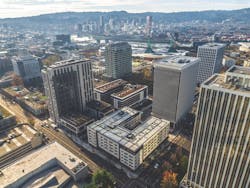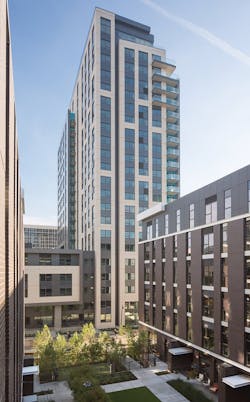Three months ago, EcoDistricts, the Portland, Ore.–based organization that advocates for district-scale urban development, launched EcoDistricts Certified version 1.2, a sustainability management framework based on EcoDistricts’ multilayered Protocol. The Protocol, which came out last April, is based on more than five years of research and consultation with 100-plus industry experts and 16 district-scale projects worldwide.
Spawned from a 2009 partnership between the city of Portland and the Portland Sustainability Institute, EcoDistricts is now part of a movement that has seen the formation of 53 ecodistricts; another 100 are in the process of formation. The organization sponsors an annual summit (its latest, in Denver, drew nearly 350 participants) and three-day incubator programs to help civic leaders develop draft roadmaps.
The EcoDistricts Protocol revolves around three imperatives—equity, climate protection, and resilience—and six priorities—resource regeneration, living infrastructure, health and well-being, connectivity, place, and prosperity. Cities that register for certification must complete three implementation stages within three years.
EcoDistricts has been gaining momentum since 2014, when it launched Target Cities, a two-year immersive pilot program. Eleven districts in nine North American cities participated. That same year, the organization trained 400 people to become EcoDistrict Accredited Professionals.
“Now, we’re designed for scale,” says Eric Corey Freed, EcoDistricts’ Chief Sustainability Officer. Santa Monica, Calif., and Boulder, Colo., have registered for certification, and as many as eight more cities are considering it. EcoDistricts envisions starting a Leadership Institute to cultivate the next generation of political and business leaders committed to its principles.
Preserving livability
The impetus behind EcoDistricts is global urbanization. By 2050, two-thirds of the world’s population could be living in cities. Over the next 20 years, cities are expected to spend $30 trillion on “urban regeneration.” Yet according to Rob Bennett, EcoDistricts’ CEO, most metro areas tend to be “disorganized” when it comes to formulating people-centric infrastructure plans. Without a cohesive growth strategy, he says, that will mean greater energy consumption and greenhouse gas emissions.
EcoDistricts’ goal is to give cities a way to go beyond thinking about just individual buildings and consider a holistic path to develop sustainable neighborhoods that involves active input from all stakeholders. This was the case in Austin, Texas, where the 85-acre Seaholm Redevelopment District has become one of EcoDistricts’ biggest success stories. EcoDistricts’ framework “weaved together what all of this development means as a whole” and provided benchmarks to measure progress, says Lucia Athens, the city’s Chief Sustainability Officer. Seaholm was a Gold winner in BD+C’s 33rd Annual Reconstruction Awards (http://bit.ly/2haflPI).
Even though EcoDistricts’ focus is on whole neighborhoods, there are cases where individual buildings have been central to an ecodistrict’s development.
Among the more noteworthy of these is the six-story Bullitt Center in Seattle, designed by Miller Hull. When it opened in 2013, the LEED Platinum Bullitt Center was called the greenest commercial building in the world; after one year of operation, its energy use intensity was a low 9.4. Bullitt Center was sited within the 525-acre Capitol Hill EcoDistrict, which the Bullitt Foundation helped create in 2011. The area was once a sea of parking lots. “Now virtually every piece of real estate is under development or redevelopment,” says Freed.
The architectural firm GGLO Design conducted site analysis and community outreach to inform initial sustainability recommendations for the Capitol Hill EcoDistrict. It is now the most densely populated urban village in the Pacific Northwest. Joel Sisolak, Sustainability and Planning Director for Capitol Hill Housing, a community developer that supports the ecodistrict, says the goal is “to keep density livable and affordable.” To that end, Capitol Hill EcoDistrict has developed a performance index with eight targets, from reducing electricity and water consumption in buildings 50% by 2030, to tripling bicycle traffic at selected intersections.
At 21 stories, Aster Tower is the tallest building in the Hassalo on 8th residential complex in Portland. The development slashes its water use by more than 50% (seven million gallons) per year by treating and recycling its water via a natural urban wastewater system. Photo: American Assets Trust/GBD Architects.
Getting city officials on the case
Lloyd EcoDistrict, one of five ecodistricts in Portland, Ore., was another early adopter. Lloyd was started about five years ago under the aegis of then-Mayor Sam Adams. The original plan focused on urban renewal, but change at first happened piecemeal, building by building, recalls Sarah Heinicke, Executive Director, Lloyd EcoDistrict.
Unlike the other ecodistricts in Portland, which are largely residential, Lloyd was heavily commercial and institutional: 20,000 people work there, but only 1,200 live there. Over the past five years, though, the ecodistrict has increased its resident count to 5,000.
Hassalo on Eighth, the first new building complex in Lloyd EcoDistrict, is seen as a catalyst. It consists of three residential towers, ranging from six to 21 stories, providing 592,616 sf for 657 apartments and 31,707 sf of retail space, plus a 26,400-sf anchor store, 271,582 sf of office space, and 1,200 parking slots. It’s targeting LEED Platinum.
GBD Architects, the project’s designer, consulted with EcoDistricts about the towers’ development. Lloyd “had a lot of things in place already” to meet the EcoDistricts’ Protocol, but “bringing in residential made the district more vibrant,” says GBD Principal Kyle Andersen, AIA.
To make the plan go, something had to be done about the neighborhood’s infrastructure, which was undersized. GBD approached Portland’s Bureau of Environmental Services about getting a break on utility hookup fees in exchange for including an on-site storm- and wastewater treatment system, known as NORM (for “natural organic recycling machine”), designed by Biohabitats. This wasn’t part of GBD’s original design, “but it parlayed with EcoDistricts’ plan,” Andersen says.
The treatment system, which serves the towers and an office building, bypasses the city’s water treatment infrastructure, which saves the landowner nearly $1.5 million a year. NORM is expected to cut the buildings’ water consumption in half. The owner, American Assets Trust, is moving ahead on another four-block redevelopment called Oregon Square, which will have 1,000 apartments, a central plaza, and a second on-site water treatment system.
Civic support was also evident in Austin’s Seaholm EcoDistrict. When fully built out, it will have added 4,000 residents, 5,000 new jobs, and 3.5 million sf of green buildings to the district, says Athens. Trammell Crow is redeveloping a former water treatment plant site into a mixed-use building with 500,436 sf of office space. A 58-story condo building is also in the works.
Another new facility that could become a beacon for Seaholm EcoDistrict is the $125 million Austin Central Library. Scheduled to open in May, the library will have a 350-seat event center, an art gallery, separate spaces for children and teens, a cooking demonstration area, a street-level café, and a rooftop garden and solar array. The 198,000-sf library, designed by Lake|Flato Architects and Shepley Bulfinch, is shooting for LEED Platinum.
Athens says that an ecodistrict’s success hinges on having elected officials who understand how everything fits together. Austin’s former mayor, Will Wynn, was instrumental in getting the city to expand its downtown cooling system to the Seaholm ecodistrict, which relieved developers from having to install chillers on their buildings’ roofs. “There’s a vision here that’s driving much deeper levels of sustainability,” says Athens. What’s happening at Seaholm could establish regulatory baselines for other neighborhoods in Austin.
Managing growth in 3 ecodistricts
Several cities that are either signed up for EcoDistricts Certified or are considering it already seem to embrace the concept of district-scale development.
Santa Monica recently became the first city in the U.S. to mandate that all new single-family homes built be net-zero energy. The city is also getting started on a modernization of City Yards, a 14.7-acre property with 16 public works buildings, some dating back to the 1940s, that can no longer support city functions.
This upgrade “will allow us to be more sustainable,” says Erin Hamant, Senior Analyst and Administrative Supervisor for the city’s Architecture Services Division. It might also become a first step toward developing a larger ecodistrict within Santa Monica’s Pico neighborhood.
The neighborhood already has business and art districts that might want to become part of an ecodistrict. “What we like about the Protocol is its scale,” says Hamant. It’s also not prescriptive, she says, so it “lets you create what works for the community.”
Devens, Mass., is home to one of the premier eco-industrial parks in the U.S. The 4,400-acre park, converted from a decommissioned Army base, has 100 businesses with more than 5,000 employees. (The park also has 400 residents, and a 124-unit net-zero-ready housing community is being built.)
Devens Enterprise Commission, the park’s regulatory authority, is considering EcoDistricts Certified as a framework for managing a major renovation and expansion that, by 2033, would increase the park’s industrial space to 8.5 million sf, from the current 5.5 million sf.
“Districts are places where people live, work, and play, but most folks don’t look at the work component,” says Peter Lowitt, DEC’s Director. “You have to make jobs and the environment compatible, and integrate social equity.”
Boulder, Colo., has some of the toughest air-quality regulations in America. It wants to reduce CO2 emissions by 80% by 2050. It is also “obsessed” with planning, says David Driskell, who until recently was Executive Director of Planning, Housing, and Sustainability.
Dating back to the 1960s, Boulder has been acquiring land around the city, to where it now owns 70 square miles of open space, surrounding a city of only 25 square miles. Last year, EcoDistricts helped Boulder conduct a charrette on one property, an old hospital adjacent to a mixed-density site with flooding problems.
Boulder has yet to formally register for EcoDistricts’ program. But Driskell says that a district-wide approach is the way for cities to wean themselves from fossil fuels: “In a world where I can capture energy and store it anywhere, buildings become different kinds of assets.”

